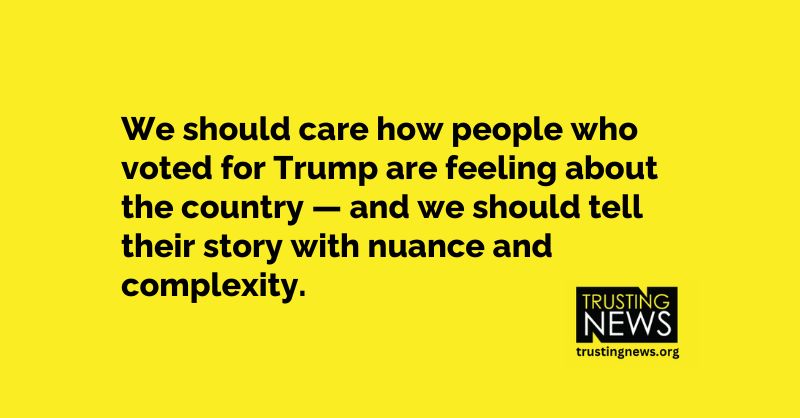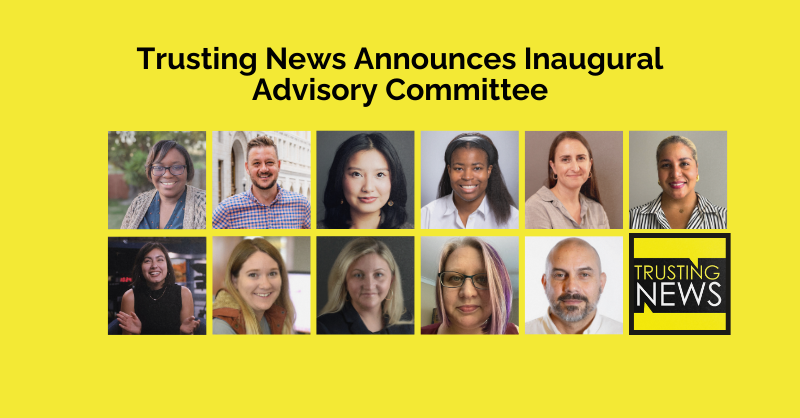
Our Trusting News team addresses recent questions we’ve been hearing from journalists and across the industry.
Yes, you should interview Trump voters (and other answers to questions we’re hearing from journalists)
In a conversation with our team last month, a reporter from a major news outlet questioned whether, in general, journalists really need to be interviewing Trump voters.
It’s a sentiment we’ve heard in other contexts in the last few months. In this case, the reporter was implying that they didn’t have anything valuable or reasonable to contribute. There may have been a bit of hyperbole in the question, but it felt layered onto genuine skepticism. Other journalists have routinely told us that amplifying the voices of Trump supporters would lead to publishing misinformation or augmenting hate.
When asked questions like this, our team generally responds by asking the journalist and newsroom questions like this:
- Do you intend to serve your whole community? If so, you should reflect your whole community in your coverage.
- Do you intend to reach your whole community? If so, remember that people won’t tune into (or certainly pay for) coverage that doesn’t reflect their values and voices.
- Do you have a goal of helping people in your community understand each other more deeply? If so, you yourselves need to understand your complex community more deeply, and you need to tell stories that reflect nuanced decision-making and motivations.
The answer to some of those might be no. You might superserve a specific community or demographic in a way that allows you to elevate their voices and leave others out. You might be solely focused on empowering and protecting people who are unsafe or otherwise significantly harmed by the current administration’s actions. If so, thank you.
No matter who you aim to serve, we hope you are questioning your own assumptions about people’s politics and motivations and asking questions about what their votes and opinions do and do not signify in the bigger picture.
It can be helpful to approach it more personally this way:
- Think about people you know and respect who voted for Trump. Do you think their voices aren’t worth hearing?
- And (this one’s the real kicker): Do you actually know and respect anyone who voted for Trump? If not, you need to reckon with the limitations of your social circles and have some humility about the lens you have on the country.
That last one speaks to public perceptions of journalism. When communities in general feel misrepresented or neglected by journalists, they assume they are not represented on or understood by newsroom staffs. And that’s a reasonable response.
So: Yes, journalists, you should care how people who voted for Trump are feeling about the country, and you should tell their story with nuance and complexity. We should strive for that same approach when covering people across our diverse communities — to tell their story in a way that they feel captures their views and experiences authentically and accurately.
We’ve gotten some big questions lately. Let’s look at a few more.
In talking about this question, we realized other questions have been coming up more regularly lately, so we’ll answer those, too.
Q: Are conservatives ever going to trust our news? Should we just stop trying?
A: No one trusts all news, and people have varied reasons for the ways they engage with news. The key is for each journalist or news outlet to determine who they AIM to reach. If you serve a specific community — if you intentionally center specific voices and information needs — then you’ll answer with that in mind. If you aim to serve an entire geographic area across diversity of age, race, politics, socioeconomics, etc., then you need to assess who you’re currently serving well — and who does not feel reflected, understood or reached by your coverage. Then you need to ask whether you’re sending signals about who your news is intended for, based on the lens through which your stories are told and your language and framing. If you want your coverage to be hearable by people across your diverse community, you should invest in understanding how it is interpreted by different folks. And if part of your mission is to be a hub of ideas and conversation for your community, you should be continually building on ramps designed with specific communities in mind.
- Our Anti-Polarization Checklist is a step-by-step guide to help you examine how your stories are framed.
- We have a News Avoider Community Interview Guide designed to help you hear from people not tuned into your coverage.
Q: We get good feedback from our audience and have a solid subscriber base. We’re fine. Why should we change what we do to earn trust?
A: If that’s true, congratulations! This is a question we’ve heard at two state press associations recently, largely from journalists in smaller communities who aren’t seeing a big dropoff in readership or increase in mistrust. Our questions back: Are you reaching a spectrum of different people in the community? Are you reaching everyone you want to reach? Are you reaching everyone you’ll want to be reaching a few years from now? If not, do you know what’s getting in the way of building trusted relationships with the folks NOT tuning into you? Who does NOT see you as relevant, useful and credible? Investigate the obstacles, and start there.
- Again, our News Avoider Community Interview Guide can help you hear from people not tuned into your coverage.
Q: Let’s say our newsroom adopts the transparency practices you’re always talking about. Are you suggesting that will solve our trust problems?
A: Nope. Adding language to a story (online, on air, in print, etc.) that explains why you’re covering it, where you found sources or how you took care to be fair will 100% not make everyone trust you. After all, people have to tune in in the first place to be exposed to that explanation. And some people have written you off entirely and won’t believe you anyway. But plenty of people are skeptical as they consume news and are looking for signs that it’s credible. And others might be inclined to give you the benefit of the doubt and are rewarded for doing so when you articulate your integrity. These steps feel — and are — incremental ones. But they signal a willingness to be held accountable and help people separate responsible information from the rest of what they’re exposed to.
- This Transparency Trust Kit guides you through how to insert transparency into your daily coverage.
- Check out our research that shows how we know transparency works.
Q: Trusting News talks about explaining the mission behind our journalism. Are you saying that’s the key to reaching people not tuning into the news I provide?
A: Telling the story of your values and of the value you offer is indeed important. We encourage you to articulate it in a way regular people can understand, and get on the record about it. But even more important is to actually be valuable and useful. Don’t focus on marketing your content if you’re not confident you’re offering something people want or need. And check whether the language you’re using to describe what you offer matches what people say they need.
Q: Our mission statement says we’re nonpartisan and independent. That’s good, right?
A: It’s a start. But what do those words mean? How do you experience them day to day? How are you backing yourself up — bringing the receipts for those values? Don’t expect that just saying them makes it obvious they are true. And also don’t expect that they mean the same thing to everyone. In a recent interview, Megyn Kelly told the New York Times that she still feels comfortable calling herself an independent journalist, even after endorsing Trump and speaking at his rally. In our minds, the most important thing is not agreeing on the meaning of the word independent. It’s painting a vivid, tangible picture of how we do our work.
- Here’s how you can explain your independence.
Q: Isn’t it a good idea to defend journalism? We should do that, right?
A: We often remind journalists that their job isn’t to defend the whole media industry. There’s a lot of unethical and irresponsible news being produced in the name of journalism. So when people are frustrated or complaining about the industry, try to avoid jumping to the stance of automatic defensiveness. Instead, get curious about people’s experiences with news. Where are they getting their information? What are their frustrations? Have they been burned by a journalist before? Leave space to hear them out, and then respond with specifics of how you and the journalists you know are working to do things differently.
- Our Community Interview Guide walks you through how to hear from your community.
- Our Dimensions of Difference guide, co-created with Spaceship Media, walks you through creating better content by helping you to identify, understand and talk about your own differences and assumptions internally.
Q: Isn’t asking people what kind of news they want to see pandering?
A: No, it’s not pandering — it’s about making your journalism more useful and relevant. Listening to your audience helps you better understand their needs and the issues they face. That insight doesn’t replace your core journalistic values and ethical standards; it is used alongside them. Gathering perspectives from outside the newsroom strengthens your reporting and helps ensure it serves your whole community, not just those who are already heard.
Also, explaining “obvious” facts isn’t pandering either. It’s giving people an on-ramp to things they’re skeptical about. With so much misinformation circulating, clearly stating and explaining facts helps people make sense of what’s true — and empowers them with reliable information.
- This Feedback Trust Kit has guidance on how to ask — and then act on — input from your community.
Q: I know people feel overwhelmed by the volume of news, but isn’t it important to give people the newest information?
A: This one comes in response to the urgency journalists feel about reporting the latest news, and the overwhelm both journalists and the public are feeling. Yes, timeliness matters — especially to news junkies. But try to remember that most people are not hungry for every new update. Their bigger challenge is understanding the big picture. And there’s a danger that journalists will make every story feel urgent — especially if the coverage lacks context. Instead, try to balance breaking news with clarity, solutions and connections to people’s everyday lives. That’s what helps audiences truly understand an issue, see its impact and know what actions they can take — not just feel more stressed, anxious and overwhelmed by the news.
On a final note: If you’re starting emails with “I hope you’re doing as well as anyone can be these days,” just remember that people feel all kinds of ways — for all kinds of reasons — about the state of the country right now. If your goal is to report nonpartisan news for a larger swath of your community, be mindful of the often subtle ways we signal who our news may be for, and who it’s not for.
Questions? Concerns? We’d love to hear!
If you have questions or want to discuss these topics further with our team, we welcome you to reach out! You can connect with us via email info@trustingnews.org or on LinkedIn, BlueSky or X. For more actionable strategies for how you can build trust with your community, subscribe to our weekly Trust Tips newsletter.
— Joy Mayer, Lynn Walsh and Mollie Muchna
At Trusting News, we learn how people decide what news to trust and turn that knowledge into actionable strategies for journalists. We train and empower journalists to take responsibility for demonstrating credibility and actively earning trust through transparency and engagement. Learn more about our work, vision and team. Subscribe to our Trust Tips newsletter. Follow us on Twitter, BlueSky and LinkedIn.




